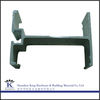- Contact Person : Ms. Fu Canna
- Company Name : Shenzhen King Hardware & Building Material Co., Ltd.
- Tel : 86-755-27266644
- Fax : 86-755-27266644
- Address : Guangdong,Shenzhen City,Shajing Town
- Country/Region : China
- Zip : 518104
Related Product Searches:Aluminum beam with wooden insert for scaffolding metal building material,High Quality Aluminum beam with wooden insert,Aluminum beam with wooden insert KH-AB-1900-001
Product detail:
1. Aluminum beam with wooden insert for scaffolding metal building material
2.Material: AL Alloy 6061,6063-T4/T5/T6
3.Size: 122mmx85mm, Thickness:3mm, L=As per your requirement
4.Loading capacity:5~6 Tons
Features:
1.It is up to 15 years long life time
2.It is durable, recyclable and safety
3.Reasonable stress and large bearing capacity
Dimension:
As per customer's requirement
What Types of Beams Are There :
Load-bearing support beams helped build many structures of the ancient world including Roman bridges and Egypt's great pyramids. Depending on many factors, including the amount of weight, soil and wind, different types of beams distribute weight in different ways. Before doing any home building or renovation, determine the best type of beam support to fit the structural needs of your project
Strain & Stress:
A beam is subject to the principals of natural laws of strain -- how much it stretches -- and stress -- how much it pulls. Steel makes the most rigid beams, aluminum beams are more flexible than titanium, and wood beams have the most elasticity. However, any beam will break when an excess amount of pressure is applied. Use the proper material with the correct amount of strain and stress properties to give adequate support for long periods of time.
I-Beam
Shaped in the form of the letter "I," the I-beam commonly supports floors since it can bear the greatest weight. Also called the "H" beam, it consists of two flat horizontal flanges, one on the top and one on the bottom, that sandwich a vertical beam called the web. The combination of the vertical and horizontal supports equally distribute the weight. Made from steel, I-beams are available in many sizes for residential and commercial projects.
Cantilever Beam
Based on torque or turning force and balance, a cantilever beam is supported only on one end. Steel reinforced concrete beams for balconies and bridges use cantilever beams to support the suspended weight. In bridge construction, trusses, triangular frame sections, help reinforce cantilever beams. The Frank Lloyd Wright house, Falling Water, uses cantilever beams to support the weight of balconies suspended over a waterfall.
Flitch Beam
An economical but strong beam made from alternating panels of wood and steel, Flitch beams help cut construction costs. Often used in residential home building, they can be attached to wood frames with nails or bolts. Lighter than I-beams, Flitch beams provide vertical and horizontal support, but cannot bear as much weight as steel beams.
C-Channel Beam
Resembling the letter "C" with one side open, the C-channel beam is ideally suited to support walkways, ramps and floors. It is made from galvanized steel and available in different colors to complement an outdoor environment when the beams are exposed, such as in parks. The long-lasting C-Channel beams are resistant to corrosion.
Wood Beams VS Steel Support Beams
Wood has traditionally been the building material for most support beams in home construction. However, with steel proving itself as an excellent building material in large buildings, it is slowly replacing wood construction in conventional homes as well. This is due to many factors, from price and availability, strength and durability, and the elimination of misconceptions. Although wood remains important in home construction, steel provides many advantages. Steel buildings can even be pre-engineered to speed construction and efficiency.
Price
Fortunately, wood and lumber is a renewable resource. Unfortunately, the rate of its needs versus how fast it is replanted is much higher. This means lumber prices can fluctuate. Steel, on the other hand, is readily available in large quantities. It is also recyclable. Steel prices, although historically higher than wood, is now on par with wood. The pricing of steel is usually consistent.
Strength
Steel support beams have very high load strength and can handle stress much better than wood. Aside from being one of the strongest building materials available for home construction, it is a manufactured metal, meaning its strength isn’t dependant on things like knots, twists, or defects that may be found in wood.
Durability
Steel is very durable and is more likely to survive natural disasters like hurricanes, earthquakes, and fire. Steel also does not rot, mold, or dry out. It is not subject to infestation and will not shrink or warp in different weather conditions. Steel supports, walls, and frames stay straight and flat through construction and during its lifetime better than wood.
Construction
Steel can be pre-engineered or prefabricated, meaning the construction is done beforehand. This can save time and money and is generally an easier way to construct a building. This is done by constructing certain parts, bodies, or pieces in a factory before they are shipped to a construction site.
Enironment
Both steel and wood have claims to being green, or environmentally-friendly. Wood grows naturally so the energy needed to process it is little. Iron on the other hand must be dug from the ground and then processed in large factories. This can create large amounts of greenhouse gases and pollution. However, while wood is a renewable resource, it is dependant on the time it takes to grow a tree and whether or not enough trees are growing. Steel is not a renewable resource, but it easier to recycle than wood. In fact, a great deal of steel in the United States is recycled.








